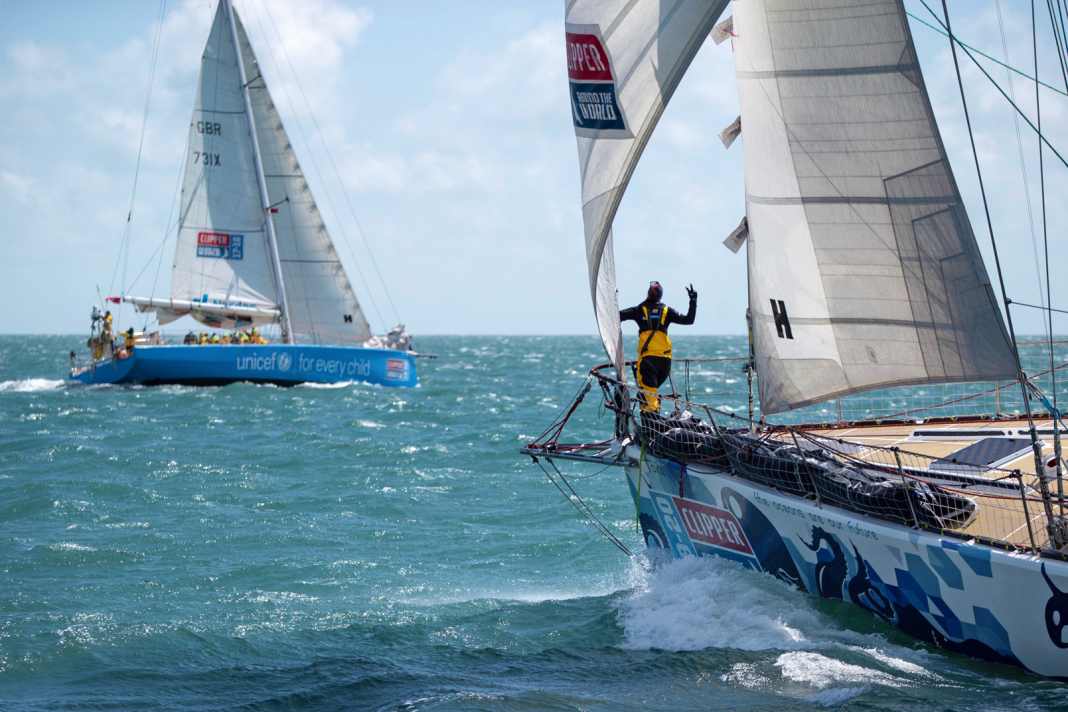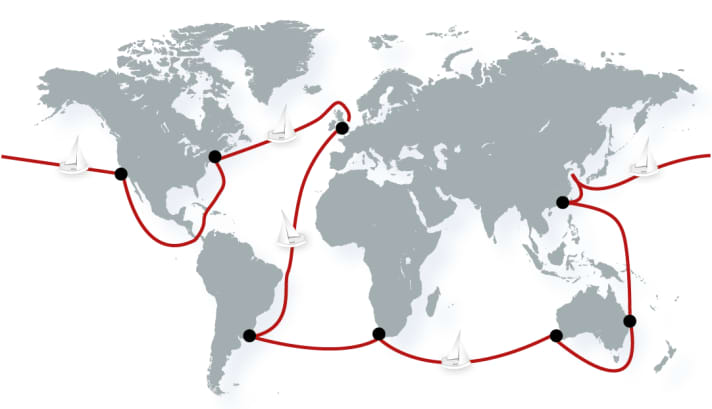





In this article:
It is at the top of most sailors' bucket lists: sailing around the world. However, there are many obstacles to the great desire for freedom, adventure and discovery: often a lack of time and money, sometimes a lack of knowledge or fear. There are several ways to overcome these obstacles. One is called the Clipper Round the World Race. This is the sporty circumnavigation with the least effort: supervised, organised, compressed in terms of time, comparatively inexpensive and even bookable in stages.
The British provider Clipper Ventures, founded and until recently run by sailing legend Sir Robin Knox-Johnston, organises the regatta every two years. Ocean sailing for all, starting in the UK and sailing around the globe on eight legs, around 40,000 nautical miles, over a period of eleven months.
There is a long process between "Oh yes, I feel like doing that" and "Oh, I'm really doing that!"
But there is a long process between "Oh yes, I want to do that" and "Oh, I really want to do that!". Although the Clipper Race offers a condensed circumnavigation of the world, this also has to be financed and takes time. The entire trip takes eleven months and costs the equivalent of around 53,000 euros, plus four weeks of training at around 7,200 euros. Then there are the costs for compulsory insurance and personal equipment, with a rate of Mustos HPX offshore oiler is provided.
But it appeals to me. For personal and technical reasons (I don't have the boat for it), I'm not going to make it around the world on my own for the time being. For my sailing adventure, I decided on five legs that seemed most interesting to me. These are the Atlantic, Pacific and Indian Ocean passages, the crossing of the equator and the International Date Line as well as the Panama Canal. The advantage of individual sections is that you can enjoy distant countries and continents for a few weeks without having to get back on the boat and move on after five or six days of stopovers. More than 80 per cent of all participants prefer individual legs of a circumnavigation.

The requirements
The candidates first have to go through an interview process, which primarily focuses on their ability to work in a team. And rightly so: after all, the large crews are crammed into a confined space for three to five weeks. Those who are invited for the first few weeks of training can be sure that they will be allowed to sail their favourite stages if they pass the tests.
The sailors
Sailing skills or even ocean and regatta experience are not required for participation. However, Clipper expects sufficient physical fitness as well as social skills. Both usually become apparent during the first week of training. The participants in the regatta usually come from all continents, but the majority are from Europe, primarily from Great Britain (almost 50 per cent), and are between 18 and 79 years old. As expected, men over a certain age (50 plus) make up a clear majority, but the proportion of women in the crews is remarkably high at just over 30 per cent. In total, there are around 700 participants spread across the eleven racing yachts and eight legs, with each boat consistently manned by a crew of 17 to 21 people, plus a professional skipper and an AQP - Additional Qualified Person (First Mate).
Clipper decides who is assigned to which team and which yacht. The decisive factor is not so much sailing experience or sporting ambition as personal and professional skills: Doctors and nurses are assigned to the boats first, then mechanics and electricians and later other people who are useful for the day-to-day operation of a yacht.
Another criterion for crew allocation is the ratio of circumnavigators to participants who only sail individual routes ("leggers"). Here, Clipper attaches great importance to distributing the skills and experience gained fairly among the boats. On average, eight circumnavigators sail on each boat.
This is the only race open to amateurs that gives them the chance to conquer the Everest of the seas, the circumnavigation" (Sir Robin Knox-Johnston)
The boats
All four training weeks take place from the harbour town of Gosport in the south of England. After getting to know the participants for the first time last May, we immediately set off on one of the training yachts. And even as a reasonably experienced sailor, I feel like I'm switching from a VW Beetle to a Formula 1 car: I had a rough idea of how sailing on such a racing machine works, but it took a few days of training before I halfway understood the layout of the boat and the rig. In the "snakepit" alone, a recess behind the mast, an impressive 15 lines come together, and not a single one of them is a sheet! Why 15 lines in the rig?
The training boats are 68-foot decommissioned racing yachts from previous events. However, you quickly get a feel for the actual race, which is sailed on modern 70-foot clipper boats. There are no cabins, just open berths that are height-adjustable on one side due to the heeling, two toilets without doors (but with smart red plastic curtains), no shower and no fridge.
The first training session
Regardless of whether there are 20 or 20,000 miles in the mileage book, every candidate is obliged to take part in all four training sessions. And for good reason: for some, the first day of training is also their first encounter with a yacht, and even for participants with sailing experience, not everything on a Clipper racing machine is self-explanatory. The training begins with a comprehensive safety briefing and check, including inflation of the assigned lifejacket.
Once winches, lines and other components have been explained, we cast off and head for the Solent. And this is where even the die-hard sea dog realises why basic training on a clipper boat is indispensable: setting the mainsail, staysail and yankee alone takes a good half an hour - and makes it clear why the boats are equipped with a coffee grinder: Setting the 150-kilogram mainsail using muscle power or a normal winch would be almost impossible. And the first tack also takes less than 25 minutes. It takes around half a dozen simple tacking manoeuvres before we even understand how the chain of command, backstays, rudder position and overtaking the two massive headsails work. A small, colourfully illustrated and waterproof manual, which is handed out to each participant and explains the procedures in the simplest possible way, provides assistance.
Although all of the skippers are friendly, professional and extremely competent, you can tell that they are a little tired. If you have to explain the same procedures over and over again for weeks and months and are looked at by 20 pairs of eyes, mostly without understanding, you inevitably fall into a routine that wears you out.
Incidentally, the training skippers are not the skippers of the actual race; these have not even been finalised at the time of the first training sessions. Rather, they are former race skippers, young aspirants for this task or simply skippers who see the training sessions as a lucrative sideline. They only have one thing in common: they are members of the training elite - RYA Ocean Master Instructors.
Crew dynamics: steering wheel and snakepit are popular, cooking and cleaning less so
The days of the first week of training always end in the harbour, which suits many participants: even if it is their first time on a sailing boat, most of them are happy to have solid ground under their feet in the evening and to be able to spend their first nights in the bunks, the less comfortable berths, without heeling.
The daily manoeuvres include the MOB - in our case a BOB, because Bob is a 40-kilogram dummy that is regularly thrown overboard: in the harbour and on open water, at night or during the day in all conditions.
Although all participants are very friendly and companionable with each other, the leading wolves emerge after the first few days, as is probably the case with any other sailing crew. With 20 or more aspirants on a boat, things become more hectic when it comes to allocating popular places such as the helm or snakepit during manoeuvres. As even the training skippers can't always keep track of who has already taken which position and when, despite rotation, the more reserved participants are often left with only the spectator's seat. The opposite is true for the less popular tasks such as cooking, washing up and cleaning, where wolves quickly become chameleons.
The days at sea
The second week of training is already being sailed in the watch system without returning to the harbour in the evening. We get a rough idea of what the race around the world will feel like. Many of us experience for the first time what it means to live on board a racing yacht, to adapt our sleeping patterns to the watch schedule and to sail in stormy nights. However, the second week starts with a full-day sea survival seminar. Here we learn how to survive on an ocean without a boat, at least for a while, how to stay together as a group and how to board a life raft. Conveniently, this part takes place in the local, heated indoor swimming pool.
In the second week, we are also constantly manoeuvring and training, and Bob also goes overboard one or two times (usually unexpectedly). While tacking took a good half an hour in the first week, we can now do it in less than ten minutes. Jibes, on the other hand, can be completed in no less than 25 minutes, as room sheet courses on the Clipper boats are always sailed with two bull poles for safety reasons. However, jibes that are at least started - and abruptly interrupted by the skipper - are not uncommon.
The tests
The assessments form the end of each training week. These include both theoretical and practical tests. Each participant has to answer questions about the boat, sails, safety measures and equipment, demonstrate a handful of knots, make radio calls and perform relatively simple exercises, such as throwing lines. It is not uncommon for one or two people to fail the assessment. In this case, Clipper offers to repeat the relevant training levels a second time (at no extra charge).
But it is not only the assessments that lead to participants dropping out of the race; for some, the experiences of the first and especially the second week of training while sailing in the watch system, with swell and heeling are reasons to cancel the planned adventure. Seasickness that lasts for days, health restrictions (especially with joints), cold and wet conditions, hard work on the sails and lines, lack of fitness and lack of sleep bring home to many the reality of an uncomfortable racing yacht.
But now we have a lengthy weighing-up process behind us and a great adventure ahead of us. And I've already become a better sailor thanks to the training sessions. Each of us is learning a lot, including about other crew members. And above all about ourselves.
- Further information under clipperroundtheworld.com
The author: Andreas Zerr. Born in Hamburg in 1971, he gained his first sailing experience at the age of eight in an Opti and has been sailing his Ohlson 8:8 in the western Baltic Sea since 2019. The freelance film producer knows areas such as the Atlantic coast, North Sea, Channel and Mediterranean and occasionally works as a training skipper on SKS trips from Kiel.

